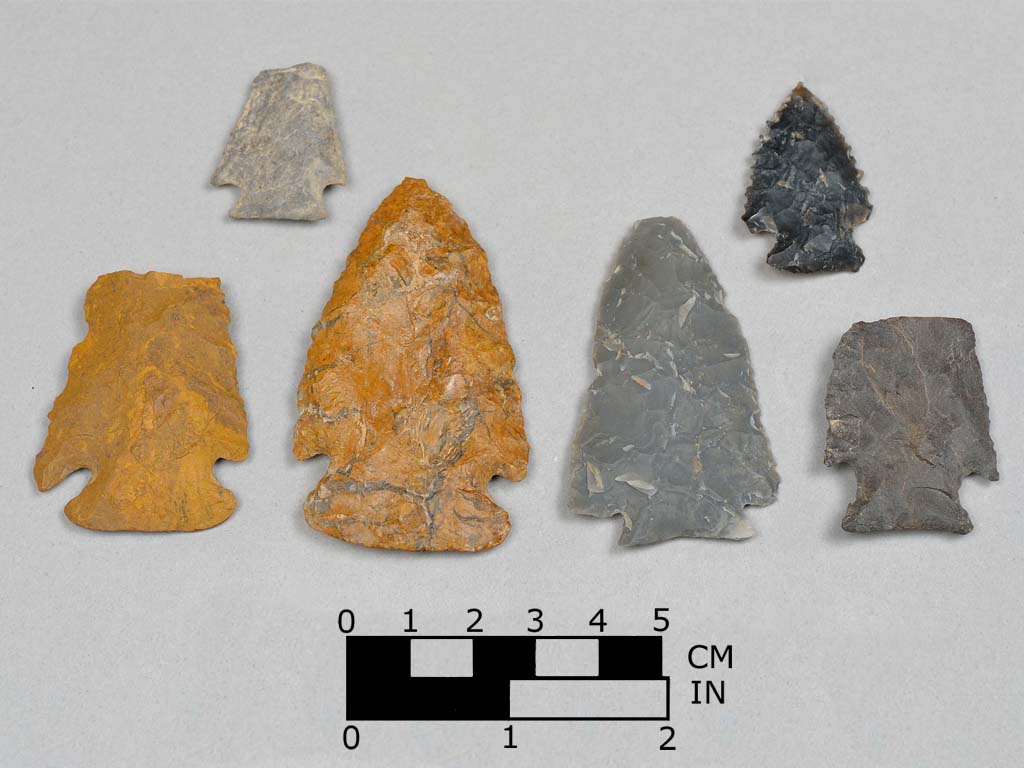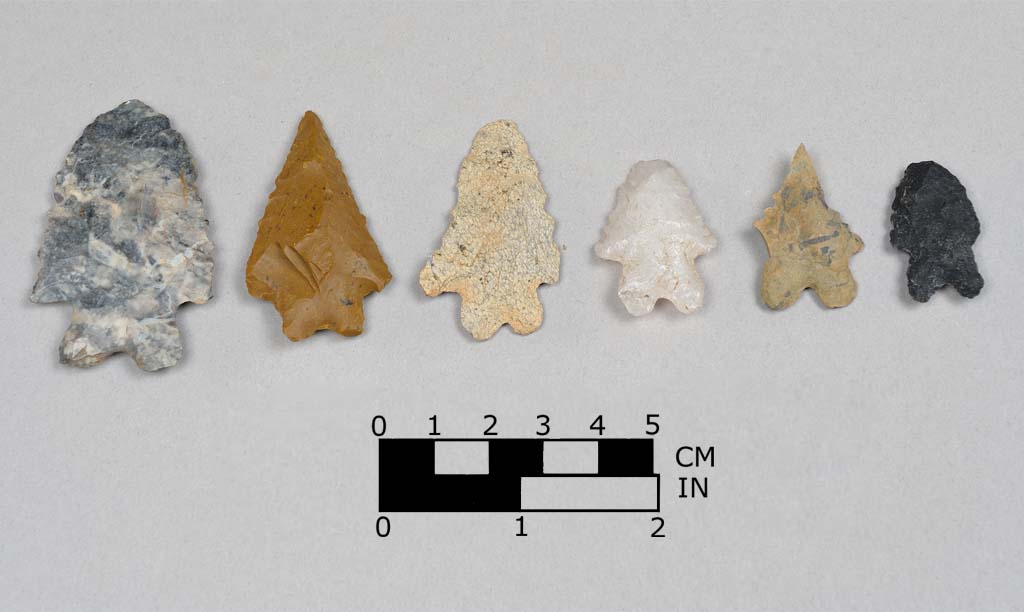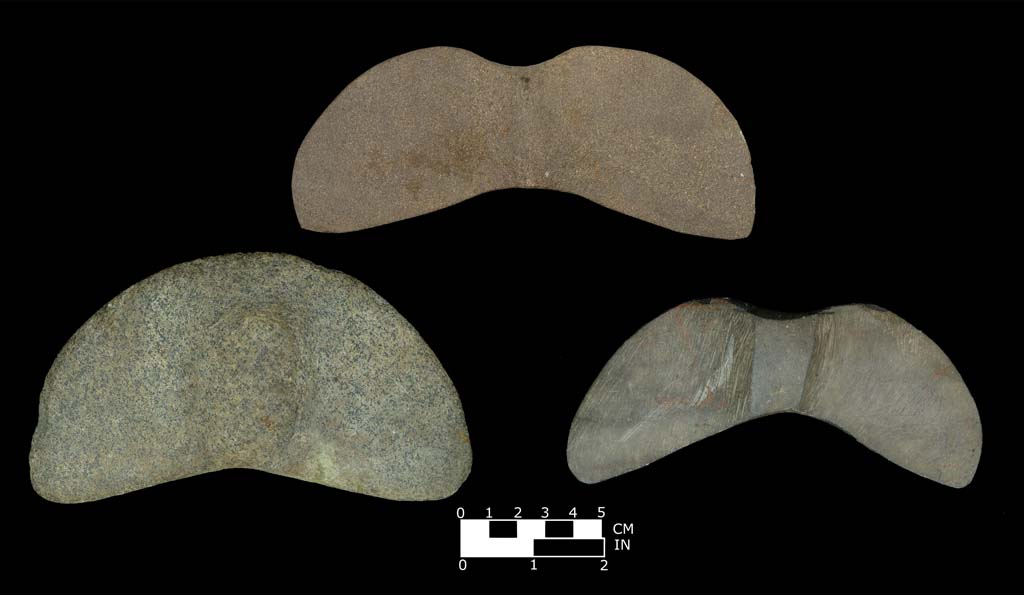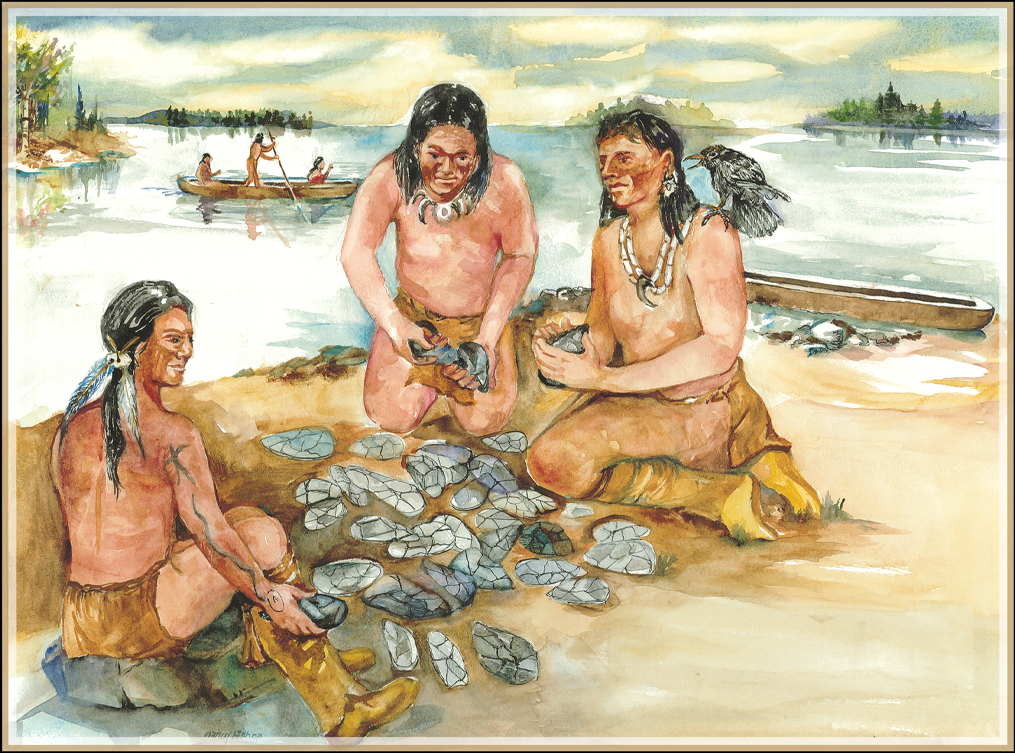Archaic Period
By 11,500 BP., the climate had warmed, and the vegetation was slowly changing. The open forest of the Ice Age was being replaced by a dense spruce-pine forest, similar to forests found in Canada today. Deciduous trees, such as oak, chestnut, and maple were gradually migrating from the south, but these broadleaf trees did not replace the spruce/pine forest until after 10,200 BP. The human population gradually increased in size throughout the Archaic Period, during which people continued to hunt, fish, and gather wild plant foods. The technology and the size of band territories evolved in response to the increasing population density and the continuing warming of the environment. The Archaic Period is divided into three sub-periods based on changes in the types of tools and other artifacts that they used.
Early Archaic Chipped Stone Spear Points
The tool technology of the Early Archaic was similar to that of the Clovis people. Fluted points, however, were replaced by distinctive, mainly corner notched points with seriated blades. Early Archaic populations were similar to Paleoindian groups in that they moved their camps frequently to be close to the food resources they needed. The spruce-pine forest was not very productive and Early Archaic peoples moved into upland areas, especially around swamps and bogs, to find food. They likely covered smaller territories than Paleoindian bands, but they continued to favor stone from a limited number of bedrock or cobble sources. By all indications, their territories continued to be relatively large. The human population did not grow significantly during this time probably due to the low density of food resources in the spruce-pine forest. Hunting probably continued to be the main subsistence pattern.

Early Archaic chipped stone spear points
By 10,100 BP., the beginning of the Middle Archaic, the climate had warmed enough to allow oak and other hardwood trees to flourish. As a result, the forest was richer in food resources, including walnuts, hickory nuts, butternuts, acorns, seeds, and berries. The birds and mammals that feed on these resources provided game for the hunters. The period from 9,100 to 10,000 BP. is associated with the use of bifurcate-based spear points. These points are distinctive and are found throughout the Southeastern portion of the United States. Although relatively common in Pennsylvania they are rarely found in New England. They seem to be associated with the spread of the oak forest and may have provided some advantage in this environment. This spear point style may have been made by a different people than those of Paleoindian/Early Archaic times and may represent a migration of people from the south.
In addition, bifurcate based points are significantly smaller than Paleoindian or Early Archaic points and may, in fact, represent a new technology. Although, it is generally believed that bow and arrow technology is associated with the Late Woodland period, these small points may signal the widespread use of archery. Bow and arrow technology dates to at least 15,000 years ago in Europe and possibly 50,000 years old in Africa. The first migrants could have introduced this technology into the New World, unfortunately wooden bows are rarely preserved in the archaeological record. The appearance of bifurcate point seems to correspond to the emergence of the deciduous forest. Archery is generally considered a more effective technology for hunting in woodlands compared to using the atlatl.
By 6,800 BP., the beginning of the Late Archaic period, population density was relatively high for a hunting and gathering way of life. There is an increase in the number of archaeological sites, and many of them are very large. The obvious implication is that the hunting and gathering bands were larger. While Middle Archaic groups were likely made up of nuclear families or small extended families, Late Archaic bands may have included several extended families related by blood or marriage. The size and composition of the band probably changed throughout the course of the seasonal round, based on the availability of food resources. For example, spring fishing camps may have included the entire band of 100 or more people, while during the winter, the band may have split into nuclear family groups to better exploit sparse food resources.
Because of the increase in population density, the territories available to each band continued to get smaller. As a result, bands intensified the exploitation of their territories by gathering a greater variety of food resources and by developing technologies to increase the efficiency of food gathering and processing. For example, they developed a variety of tools for grinding seeds and nuts and they began fishing with nets to increase their harvest. They used a variety of spear point styles and, as in the Middle Archaic, they were most frequently made from whatever useable stone was nearby. Bannerstones or atlatl weights are found on Late Archaic sites. These are the stone weights that were placed on the end of the spear thrower to increase its force.
The Middle and Late Archaic Periods represent a 6,000-year period of population growth and a corresponding gradual change in cultural adaptations to extract more food from the environment. It may also have been a period of increasing group identification as related bands customized their adaptations to the specific environments in different regions of the state. The southeastern (Piedmont Archaic), the southwestern (Panhandle Archaic), and the northern (Laurentian Archaic) portions of the Commonwealth each seemed to have had its own distinctive tool kit. What is not known is whether these groups represented different tribes, or language groups, or whether they were simply selecting the most effective tools for use in different environments.
The Archaic period is an interesting time of improving environmental conditions, resulting in a rich environment for humans to inhabit. Native American populations increased at least five-fold over Paleoindian times. As the region filled up with people, groups were forced to exploit smaller territories. There is an increase in wood working tools, fishing tools, and seed/nut grinding tools. Along with the smaller territories, these tools obviously mean that people were being forced into using more efficient tools to gather food resources from smaller regions.


